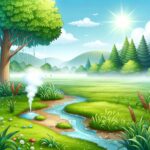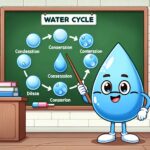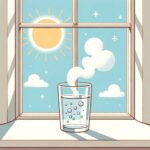In this captivating article, we will take a mesmerizing journey into the world of science and unravel the mysteries surrounding condensation and evaporation. Brace yourself for a riveting exploration of these fascinating natural phenomena, as we delve into the enchanting secrets that lie behind the processes of transforming liquid to vapor and back again. Get ready to be amazed by the mind-boggling facts and captivating insights that will leave you in awe of the intricate workings of condensation and evaporation. So, buckle up and prepare to have your curiosity ignited as we embark on an exhilarating quest to unravel the wonders of condensation and evaporation!
Condensation and Evaporation Facts
Evaporation and condensation are natural phenomena that occur all around us. They are fundamental processes that play a significant role in our everyday lives and the world we live in. By understanding the basics of these processes, we can gain a greater appreciation for the wonders of condensation and evaporation. So, let’s dive into some fascinating facts about these intriguing phenomena!
At a molecular level, all matter is composed of tiny moving particles called molecules. These molecules are constantly in motion, and their behavior changes depending on the state of matter – solid, liquid, or gas. When matter is in its liquid state, it has a tendency to transform into a gas through the process of evaporation.
Fact 1: Evaporation is the transformation of matter from a liquid to a gas. This process occurs when water molecules gain enough energy to break free from the liquid and become a gas, forming water vapor. You can observe evaporation in action when you see water evaporating from a puddle, a wet shirt drying under the sun, or steam rising from a hot cup of tea. It’s a remarkable transformation happening right before our eyes!
Quote: “Evaporation is like a magical dance, where water molecules escape from the liquid state and soar freely into the air.”
As water evaporates into the air, it forms clouds. This brings us to the intriguing process of condensation.
Fact 2: Condensation is the transformation of matter from a gas to a liquid. It occurs when water vapor cools down and transforms into tiny drops of liquid water. This mesmerizing process can be witnessed when you see the mist forming on a cold beverage or the fog blanketing the landscape in the early morning. These water droplets come together to create clouds, which are stunning formations in the sky.
Quote: “Condensation is like a symphony of water vapor molecules, coming together to form a beautiful chorus of liquid droplets.”
Evaporation and condensation are tightly interconnected, and they are part of a continuous cycle in nature known as the water cycle. The water cycle involves the constant movement of water between the Earth’s surface and the atmosphere. Evaporation lifts water vapor into the air, which then cools down and condenses into clouds. Eventually, this condensed water falls back to the Earth as precipitation, replenishing our rivers, lakes, and reservoirs.
Fact 3: Evaporation and condensation are essential components of the water cycle. They act as key drivers, shaping our weather patterns and maintaining the delicate balance of our ecosystems. Without evaporation and condensation, we wouldn’t have rainfall or the life-sustaining water sources that we rely on.
Quote: “Evaporation and condensation are the invisible forces that orchestrate the water cycle, ensuring the Earth’s water circulates and sustains life.”
The altitude also influences the processes of evaporation and condensation. As we ascend to higher altitudes, the boiling point of water decreases due to the lower air pressure. This means that water evaporates more readily, even at lower temperatures. The cooling of the air at higher altitudes also promotes condensation, leading to the formation of clouds and precipitation.
Fact 4: Altitude affects evaporation and condensation. As the air becomes thinner at higher altitudes, water molecules have more space to move and escape into the atmosphere. This results in enhanced evaporation and a greater likelihood of condensation and cloud formation.
Quote: “Altitude is like a magical boost for evaporation and condensation, adding a touch of mystery to the sky’s dynamic dance.”
In summary, condensation and evaporation are fascinating natural processes that shape the world around us. The transformation of matter from one state to another – from liquid to gas and back to liquid – is an intricate dance of molecules that occurs constantly. By understanding these processes, we can marvel at the magic happening in our atmosphere, appreciate the importance of the water cycle, and gain a deeper connection with the wonders of condensation and evaporation.
Quote: “Unlocking the mysteries of condensation and evaporation invites us to explore the hidden beauty of the everyday world, as we witness the marvels of matter transforming before our eyes.”
Condensation and evaporation are two fascinating phenomena that play a crucial role in our everyday lives. Have you ever wondered how water transforms from a liquid state to a gaseous form or vice versa? If you’re curious to learn more about these processes and their significance, we’ve got you covered. Explore our collection of mind-blowing facts about condensation and evaporation, and unravel the mysteries behind these natural wonders. Click here to dig deeper into the facts about condensation and evaporation: facts about condensation and evaporation.
FAQ
Question 1
What are the different states in which matter can exist?
Answer 1
Matter can exist in three different states: solid, liquid, or gas.
Question 2
What is evaporation?
Answer 2
Evaporation is the process through which matter changes from a liquid to a gas.
Question 3
What is condensation?
Answer 3
Condensation is the process through which matter changes from a gas to a liquid.
Question 4
How do evaporation and condensation relate to the water cycle?
Answer 4
Evaporation and condensation are natural phenomena that play a significant role in the water cycle. When water evaporates into the air, it forms clouds. The reverse process, condensation, occurs when water vapor cools down and transforms into tiny drops of liquid water, forming clouds.
Question 5
How are evaporation and condensation affected by altitude?
Answer 5
Altitude affects evaporation and condensation. As altitude increases, the boiling point of water decreases, leading to changes in the rates of evaporation and condensation.
“`json
“`
- China II Review: Delicious Food & Speedy Service - April 17, 2025
- Understand Virginia’s Flag: History & Debate - April 17, 2025
- Explore Long Island’s Map: Unique Regions & Insights - April 17, 2025
















